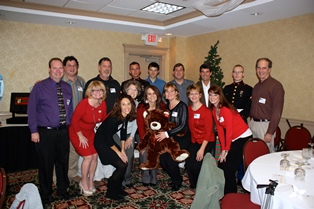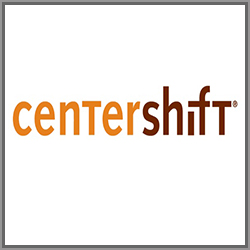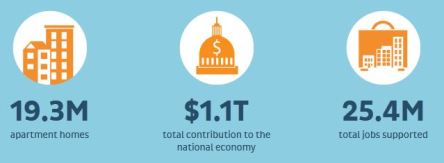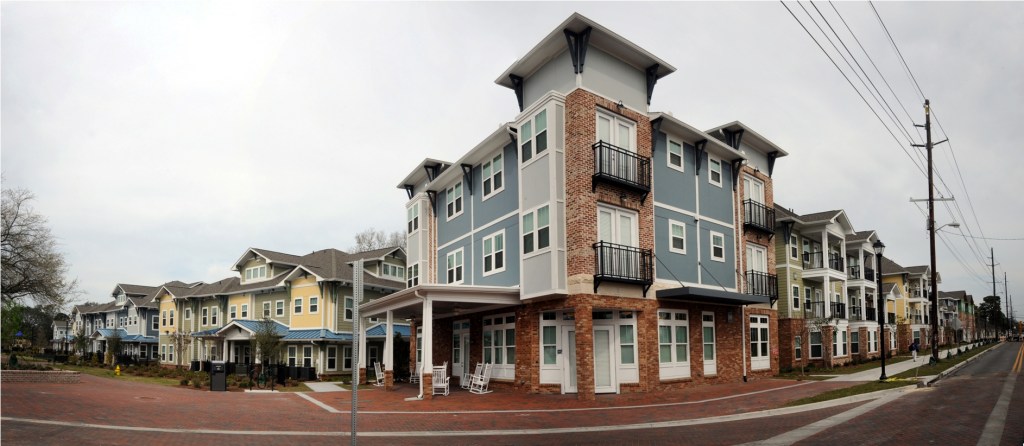Yardi client BRG Apartments is the largest owner and operator of rental communities in the region with more than 6,800 apartment homes in 40 communities throughout Cincinnati, Columbus, Dayton, and Northern Kentucky. The company takes pride in its Midwestern heritage. From the corporate office down to its smallest property, BRG instills the values of hospitality and philanthropy through community service. Jennifer Illanz, Training and Marketing Manager at BRG, believes that community service is integrated into the company’s mission statement. “Volunteerism is important because it helps express our mission statement, ‘and we care,’” she says. “Being locally owned and managed creates a sense of community within the community; we’re setting up in these neighborhoods and we want to show that we don’t just care about the properties, we care about the surrounding communities.” The culture of volunteerism benefits charity recipients as well as BRG employees. “[BRG employees] gain a sense of pride,” explains Illanz. “They see that it’s not just a job that they’re going to everyday. Volunteering with BRG makes them feel like they’re part of a family that is giving back to the community. It’s definitely a positive thing.” BRG begins the philanthropy from within, rallying support amongst its ranks for pressing social issues. In past years, BRG participated in the March of Dimes March for Babies Walk and raised over $20,000. This year, BRG chose to participate in a local event, Walk Ahead for a Brain Tumor Cure. Illanz says, “Three people within our corporate office have been personally affected by a brain tumor. Throughout the preparation for this walk we found out that even more employees were affected. We had over 50 people attend the walk and we raised over $8,000. The walk was a huge success.” BRG also sponsors local...
Building Bozzuto
An interview with Julie Smith
On a crisp mid-fall morning, the delicious smell of baking English muffins wafts from the Mid-Atlantic Baking Company out over the row houses and taverns of Fell’s Point, a historic Baltimore neighborhood in the city’s Inner Harbor. People are walking their dogs along the waterfront, the trees are pleasant hues of red and gold, and on South Wolfe Street, a new community is just waking up. The Bozzuto Group’s Union Wharf is the newest luxury apartment enclave in Fell’s Point. It abuts the harbor, with rental slips for pleasure boats available right outside. Its interior and exterior finishes draw inspiration from the historic seafaring lifestyle that created this charming community, now resurrected with popular bars, restaurants, shops, galleries, and many apartment homes. Just across the street from Union Wharf is the Red Star, now a modern tavern serving lunch, wine and cocktails, but once a destination for sailors whose ships had docked in the harbor, and they could follow red stars painted on the sidewalk to find a thirst-quenching libation or perhaps the company of a lady of the night. Long gone are the days of sailors and brothels, but some of the best bits of Fell’s Point – and Union Wharf – honor the very far past. “We designed it to fit into the community. We have reclaimed floors, beams from shipyards, we’ve got lots of industrial finishes here,” said Julie Smith, President of the Bozzuto Management Company, as she sits near a full-length plate glass window looking out on Wolfe Street, with the Red Star right across the way. “We really designed this to capitalize on the views and to feel comfortable and casual, but at the same time to pay homage to the community that it’s in. We think it’s a reflection of the Fell’s Point community and the history of the neighborhood.” Smith and the entire Bozzuto team are very proud of Union Wharf, and rightly so. Now halfway complete and occupied, the project was a challenge to design and build. Situated on a narrow strip of land that was previously a parking lot, the 280 units, plus nearly 6,000 square feet of retail and a parking garage, are shoehorned into the unusual property configuration but still manage to maximize the harbor views. Some of the apartments overlook an infinity lap pool that stretches from the lobby right out to the boardwalk. “The construction trailer was on a floating barge,” Smith recalls. “It was a very complicated project, on a long skinny site, so everything about it was hard. The design was difficult, the unit plans were tricky, even trying to figure out where to put the front desk was challenging. It was a unique site to stage, an intriguing site to design, and it was hard to build, too. Now we look back and it’s a gorgeous property, very unique, but it was a lot of work to get here.” Smith has come to Baltimore on a Monday morning for several meetings, including her interview with us. She’s impeccably dressed in an eggplant-colored suit and heels and looks as though she could be about to anchor a nightly news program on CNN. Just a year away from marking 25 years of work at Bozzuto, she’s helped build and lead a company that has continued to be known for its boutique management style, even as the portfolio size has grown from 2,000 units to nearly 40,000. In 2013, Smith was recognized as one of the multi-family industry’s most successful executives by Multifamily Executive, an honor she describes as “overwhelming,” especially when people she hadn’t seen in years began to reach out. “I was really excited by the number of people that I was able to connect with and reconnect with that I hadn’t seen in a long, long time. It really brought a lot of people out of the woodwork,” she said. That there were...
Historic Honor
Presidio Trust Recognized
Yardi client The Presidio Trust has been honored with an award from the National Trust/Advisory Council for Historic Preservation. The Presidio Landmark Apartments, a 154-unit complex, were developed by converting a former hospital on the historic San Francisco military base into multifamily living. The process involved a public-private partnership that not only preserved the historic character of the existing property but created a new sustainable community to help address San Francisco’s dire need for housing. The $71 million, 220,000 square foot renovation project was completed in 2010, according to a report in Multi-Family News. The Presidio Trust worked with Forest City Enterprises and Perkins+Will architects to design and execute the work. According to the Presidio Landmark website, “Nowhere else in San Francisco will you find an historic building that’s been thoughtfully and sustainably renovated, with modern comforts, conveniences and pampering services — all within a National Park.” Preserved features from the original hospital property include sun porches, marble hallways, doors and windows, and the brick exterior. Construction work was completed to LEED Gold certification. Perched along the edge of the Pacific at the mouth of the San Francisco Bay, the Presidio was once home to thousands of military personnel. Other reuses of buildings on the property include conversion of an officer’s quarters to create a boutique hotel. The Presidio Trust uses Yardi Voyager to manage its commercial and residential leases. There are 3,000 residents and 200 leaseholders within the Presidio, which became financially self-sufficient under its unique management set-up in 2013. The U.S. Army turned the property over to the National Park Service in 1994, and the Trust was established to achieve revenue growth and financial stability in 1996. “We pride ourselves on the careful management of the park’s finances. Implementing Voyager to capture...
Time for a Change?
Should the American time zone system be rethought?
When CNN listed time zone reduction on its 10 Ideas, readers like me smiled politely and continued to the next article. Big changes don’t happen often in our society and they certainly don’t happen quickly. Changing American time zones seems incredibly unlikely unless we’re convinced that it would make our lives exponentially better and, of course, not lead to national disaster. An America with two time zones could definitely make our lives easier. It won’t cause national chaos, either. As a matter of fact, the US did not instate our current zone system until 1883. We weren’t introduced to daylight savings time until 1918. Everyone survived. Allison Schrager’s proposal would eliminate daylight savings time entirely. It would also unite the US by two time zones with Eastern Time one hour ahead of Western Time. Adverse effects would be minimal. It may be brighter or darker outside at dinnertime but we already experience that at the solstices. As for positive effects, eliminating time zones could help businesses save time and money in several ways: Businesses would not need several call center locations or shifts to staff their offices. With only one hour differential between coasts, one team on either coast could service the entire nation. Streamlined marketing simplifies social media updates, push notifications, and other outreach efforts. Webinars and conference calls become easier to schedule, particularly when making calls to states that straddle more than one time zone such as Texas, Tennessee and West Virginia. Employee productivity stands to increase with the implementation of a two zone system. Fewer working hours are lost when traveling between coasts. Employees will also be able to transition more smoothly without jetlag, boosting productivity and creativity. No more nodding and smiling while sleeping with your eyes open. Businesses could lose less money to airlines, likely saving millions when employees must change flights due to scheduling errors. According to the US Department of Transportation, airlines gained more than $2.5 billion in ticket-change fees in 2012 alone. Businesses lose countless hours of productivity during major sporting events. Sports fans alter their work schedules—generally leaving early and reducing productivity—in preparation for games. When competing teams are from different time zones, games are scheduled to appease the most viewers, requiring compromise (thus altered work schedules) on both extremes. Without a three-hour time difference, major sporting events could be scheduled at times that do not interfere with typical business hours. There is also the matter of national equality, which has farther reaching effects than commerce. The eastern-most time zones hold large populations and greater political influence; most swing states are located along the East Coast. As a result, federal elections are generally “called” hours before polls on the West Coast have closed. West Coast poll closings are anticlimactic at best. At worst, decisions are influenced by results from the opposite coast. The one hour differential could notably level the playing field. Do you think a two time zone system could work for America? What drawbacks could come from the...
GSMA Mobile World
Internet of Everything
Once again, Barcelona hosted the GSMA Mobile World Congress, a global showcase where some of the industry’s biggest names displayed their latest toys. This year’s event featured over 1,800 exhibiting companies, more than 85,000 visitors from 201 countries, a new record, reflecting again how pervasive mobile has become. The four-day conference and exhibition became the meeting spot for executives from mobile operators, software companies, equipment providers, internet companies, and automotive, finance, and healthcare industries, topped by government delegations from all over the world. More than 4,500 CEOs, including Facebook’s Mark Zuckerberg and IMB’s Virginia Rometty held keynotes, followed by CEOs and senior executives from companies like Alcatel-Lucent, América Móvil, Bitcoin Foundation, Cisco, Citigroup, Connecthings, EMC Corporation, Etisalat Group, Ford Motor Company, Isis, Jasper Wireless, Kakao Corp., KDDI, Lookout, Millicom, NTT DOCOMO, Raspberry Pi Foundation, Shazam Entertainment, Shhmooze, SingTel, SK Planet, Tele2 Group, Viacom International Media Networks and WhatsApp. The Connected City attracted over 17,000 visitors over the four days, and presented mobile solutions for services like education, health, retail, transport, smart cities and more. The Internet of Things describes the phenomenon of network-connected sensors incorporated into devices that in the past were standalone appliances. An even broader term, ‘The Internet of Everything’, includes smartphones and other mobile computing devices, as well as Internet-connected appliances. Remember Google’s move earlier this year, the $3 billion acquisition of Nest’s smart thermostat and smoke alarm technology. A wide variety of vendors showed or announced services and products that fit the concept. The automakers announced connectivity technology this week, to meet consumers’ expectation of having the same connected experience with their cars as they have with their mobile phones. Deutsche Telekom announced a deal with PayPal through which it will enable the possibility for the mobile users to purchase...
Yardi Voyager for Student Housing
Single platform management solution
The power and versatility of Yardi Voyager®, the Yardi Multifamily Suite™ and the Yardi Marketing Suite™, are now available for marketing and managing student housing properties. Yardi Voyager® for Student Housing integrates every aspect of student housing management, from marketing and roommate selection to online payments and resident services. Students can easily discover properties with RentCafe™, which harnesses social media networking, and begin an online application process that includes setting roommate criteria, choosing unit types and completing screening and credit checks. Yardi Voyager for Student Housing accommodates nonstandard leasing periods, such as semesters and quarters, along with standard lease arrangements. After moving into a property, an optional RentCafe portal supports online services such as payments by students or their responsible financial parties and work order submissions. The solution’s compatibility with Yardi Marketing Suite and Yardi Multifamily Suite for call center, resident screening, maintenance, and utility billing and energy management lets managers of multiple property types easily add student housing to their portfolios. “This is a dedicated housing module that makes residential life easier for property managers, students and their parents or guardians. Yardi Voyager for Student Housing supports social media marketing and other online sources favored by students and communicates by email with applicants throughout the application process. Students living at the properties can obtain quality-of-life services through RentCafe, and convenient online tracking is available to parents and other responsible financial parties,” said Dan Campbell, vice president of government services for Yardi. For more information, visit...
LEED v4 Goes Live
Coherence & Efficiency
The U.S. Green Building Council (USGBC) officially launched LEED v4, the newest version of the LEED green building program, at the Greenbuild International Conference and Expo in Philadelphia. Ever since the first LEED Pilot Project Program (also known as LEED Version 1.0) was introduced at the USGBC Membership Summit in August 1998, the LEED, or Leadership in Energy & Environmental Design program, has revolutionized the way buildings and communities are designed, constructed and operated. Whereas the first series of rating systems were developed to largely address the needs of owner-occupied new construction commercial buildings, the program has grown, evolved and expanded to encompass the different project development and delivery processes that exist in the U.S. building design and construction market, through rating systems for specific building typologies, sectors and project scopes: Core & Shell Development, New Construction and Major Renovations, Schools, Existing Buildings: Operations & Maintenance, Neighborhood Development, Retail, Healthcare, Homes, and Commercial Interiors. Moreover, LEED seeks to accelerate green building demand, delivery and accessibility and optimize the use of natural resources. While still based on the essential principles advocated by its previous versions, LEED v4 brings a plus of coherence and efficiency to the whole process. “LEED v4 is a quantum leap for LEED,” said Rick Fedrizzi, president, CEO and founding chair, USGBC. “Over the past 15 years, LEED has fundamentally revolutionized how we design, construct, operate and maintain our buildings and communities. LEED has created a completely new industry of business enterprise committed to energy savings and efficiency. LEED v4 is as much a testament to the achievements of LEED project teams around the world as it is to the green building community’s ambition to create significant global and local change through resource-efficient, cost-effective green buildings.” The program’s goal is to foster...
Centershift Acquisition...
Self-storage technology leader
Yardi® announced today that it has acquired Centershift®, an innovative technology leader focused on the self-storage industry. The Centershift Store™ platform is the first fully cloud-based management system designed specifically for self-storage businesses. Understanding the benefits of a centralized data system, the industry’s largest and most powerful operators have adopted Store as the hub of their storage operations. “We are extremely pleased to be joining the Yardi team,” said James Hafen, president and CEO for Centershift. “We have long recognized that the self-storage industry was under-served when it came to technology. The breadth of services that Yardi brings to the table surpasses everything self-storage operators have come to expect from the technology available to them today. Joining Yardi introduces new possibilities to this increasingly sophisticated market, and that is an exciting prospect for all of us.” Hafen further commented, in a letter to his customers: “While we will continue to support our current software applications for as long as our clients want them, we will also begin working with Yardi to develop a self-storage management suite of products within the Yardi Voyager framework. The Yardi Voyager real estate management application services thousands of customers worldwide and offers a breadth of functionality far beyond what is found in the self-storage industry today. Yardi brings a game-changing platform that will accelerate our ability to achieve our overall goals for Centershift customers and the industry as a whole. The combination of Yardi’s immense resources and Centershift’s self-storage industry expertise will allow us to provide amazing benefits for our customers.” Gordon Morrell, executive vice president and chief operating officer for Yardi, added, “We are delighted to welcome the Centershift team and to get to work leveraging our respective strengths to benefit the self-storage market.” The Centershift team will...
A Big Impact
Apartments and the economy
They’re the housing option of choice for millions of Americans, and have gained both development momentum and resident popularity over the last five years. But apartments are not just a roof over our heads at night. They are businesses that provide a major contribution to the U.S. economy. as illustrated by this infographic from the National Apartment Association and National Multifamily Housing Council. WeAreApartments.org offers you the chance to measure the economic impact of an apartment community of any size in any U.S. state. Simply navigate to http://weareapartments.org/calculator/search and enter a few basic points of information, and you can find out how much the apartment community you own or manage contributes to the community – both in operations and thanks to the residents who live there. For a broader view of the Trillion Dollar Apartment Industry, check out this infographic: Source: http://weareapartments.org/ ...
Guy Brown
Yardi
Yardi clients who have had the pleasure of learning from Guy Brown, a senior consultant in the Professional Services Group, or his wife Deborah, Director of Development, may have caught on that they are interacting with a pretty prestigious power couple. Both Browns have each logged nearly 15 years of service to Yardi, and made notable contributions to the continually improving Voyager reporting process. Deborah currently focuses on the company’s condominium clients and manages the standard Interfaces program, while Guy is involved in writing custom Voyager pages and client training. “We have different styles and different skill sets. But she’s clearly the brains of the operation,” said of his wife, who he met when both happened to be in Israel as teenagers. Deborah, who called California home, was studying at an American high school there, and Guy, a native of England, was visiting a friend whose father was in the British Foreign Service. Fast-forward 44 years, and they’ve made successful lives and careers in Santa Barbara, where they settled in 1980. Their two children, Anna and Shannon, are equally hard-working and innovative. Anna just finished her Ph.D. in chemistry at Portland State University and is involved in nanoparticle research on the chemical element bismuth. Shannon is an environmental scientist who works as a cartographer for a consulting firm in San Diego. “They’re like me – they want to understand the way the world works,” Guy said of the couple’s children. Indeed, his passion and interest in astrophysics, physics, magnetics, materials, geology and more has created diverse opportunities for work and research. Though he studied physics in college, Guy’s first job in Santa Barbara was in computer manufacturing, at a company called InfoMag. He became an engineer, drawing from his magnetics research to develop processes...
Sapphire Glass
Powered by the sun
Apple’s highly-anticipated sapphire glass will not only offer super-protection to our favorite electronic devices, but will also improve battery life by the addition of solar-powered charging cells. Sapphire is one of the three gem-varieties of corundum, the other two being ruby – corundum in a shade of red – and padparadscha – a pinkish-orange. Although blue is the most common color, corundum can also be colorless or pink, green, and shades of gray and black. It can be mined or artificially produced. Sapphire is more than a beautiful and extremely expensive gem. Because of its remarkable hardness – 9 on the Mohs scale, right after the diamond which scores the maximum 10 – sapphires are used in non-ornamental tasks such as infrared optical components (red ruby sapphires are utilized to create new-infrared lasers due to their capacity to be turned to the appropriate wavelengths, because of the titanium and chromium impurities that form them), high durability windows for high pressure diagnostic and scientific equipment, including bullet proof glass, wristwatch crystals and movement bearings, and scratch-resistant coverings for lenses and high-end watch faces (Rolex, Citizen, etc.) It is important to note that Corning Gorilla Glass scores ~7 on the Mohs scale. Very high-end smartphones are already using sapphire crystal screens. The handmade Vertu Ti has a 3.7-inch crystal-covered screen, but thus far the technology has been too expensive for mass produced smartphone screens. Apple started using it to protect the cameras on the iPhone and, more recently, on the home button for the 5S model. But things are not about to stop here. In a post on the Seeking Alpha investor blog, Matt Margolis concludes that the $578m deal Apple struck with GT Advanced Technologies has more than just the sapphire glass growth initiative behind...
Affordability Crisis
Hurting for housing
Every morning at 8am, the construction crews begin working on the neighborhood behind my home in an Atlanta suburb. The sounds of hammers, trucks, and lively music are a sign that the housing market is recovering. While these lots will make lovely homes for some, their $250,000+ price tags exclude buyers most in need of housing relief. The nationwide shortage of affordable housing is getting worse. There’s no housing shortage. Skylines receive new jewels every quarter as developers jump on the luxury high-rise trend. Even single-family builders are stretching their legs with post-recession vigor. Big spenders have an increasing number of options. Middle- and low-income families, however, are the ones scrambling to find shelter while making ends meet. There are two notable causes for the affordable housing shortage: the widening chasm between incomes and rents, and investors’ lack of interest in affordable housing. The gap between incomes and rents grows wider. Research conducted by the Joint Center for Housing Studies (JCHS) shows median incomes plummet by 13 percent between 2000 -2012. While incomes decreased, the population of extremely low-income renters doubled in less than a decade. Of renters making less than $15,000 per year, 24 percent reported hardships with lease payments. Rent—not transportation, electronics, or clothing—is continually absorbing a larger amount of American’s income. The lowest-income renters are scaling back on food, sacrificing about $100 each month to pay for housing. The JCHS study revealed that half of today’s renters spend more than 30 percent of their income on housing; one in four families spend more than 50 percent. A study by National Low Income Housing Coalition (NLIHC) places that percentage closer to 75 percent. Incomes shrink while rent rates are continuing to increase. From 2000-2012, median rents skyrocketed by 6 percent. Rising costs can’t dissuade renters. There aren’t many other options. The influx of post-recession renters to the market drives fierce competition, turning even the priciest, tiniest rentals into a battleground. In these cost wars, low-income renters have been left out of the negotiations. There simply aren’t enough affordable units to go around. NLIHC estimates that there are 10.1 million extremely low-income households and only 5.6 million housing units to accommodate them. Almost half of these household contain children and are at high-risk for homelessness if more housing is not created. But affordable housing has not been on the top of many agendas. In 2008, President George W. Bush initiated The National Housing Trust Fund. The fund would create, maintain, and renovate affordable rental housing communities. Though he gained support from both sides of the aisle, the trust never received funds. Affordable housing faces local setbacks as well. Some local governments and community groups refuse to approve affordable housing in their areas. Their concerns are rooted in antiquated views and stigmas surrounding affordable housing. Home Matters was created in 2013 to educate local powers about the new and improved face of affordable housing: eco-friendly, stylish neighborhoods that are rich with engaging community programs and increasingly self-sufficient tenants. Nearly 200 local and national organizations have joined forces under Home Matters. They hope to change public opinion about affordable housing and in turn increase support and funding for these vital...
The Kill Switch
High security or high risk?
Today’s smartphones hold more private data than a credit card. A credit card comes with a “kill switch” but your smartphone does not. If your credit card is stolen, you can have it disabled. Any access to your account using the old card number will be forbidden. Yet if your smartphone is stolen, you and your company are more vulnerable than ever. A few developers have created software that disables mobile devices. All that would be required to activate the kill switch is a verification process, much like what is undergone when you’re canceling credit card. Companies and individuals can potentially save a lot of money and effort when kill switch technology hits the market. A kill switch can provide improved security for businesses by keeping private data out of the wrong hands. The 2013 Cost of Data Breach Study issued by Ponemon suggests that US companies have the most costly data breaches at $199 per record. This brings total costs to about $5.4 million annually. Cybercrime that may come as a result of compromised data leads to $300 billion to $1 trillion in damages. Companies could greatly decrease the cleanup costs of data breaches with a kill switch on corporate smartphones, tablets, and laptops. Companies can also protect themselves against disgruntled and negligent employees. Cisco reports that: 20 percent of IT professionals said disgruntled employees were their biggest concern in the insider threat arena 39 percent of IT professionals were more concerned about the threat from their own employees than the threat from outside hackers. 11 percent of employees reported that they or fellow employees accessed unauthorized information and sold it for profit, or stole computers. If a company is able to disarm its issued devices when needed, the company will be better...
Surviving the Drought
Water-saving tips for multifamily
Rain and snow in California have been so scarce over the last three years that about 95 percent of the state is in drought. Along environmental challenges, the ongoing drought has led to a stressed water system which menaces everything from local economies to agriculture and day-to-day living. And although there’s been a slight improvement with the heavy rains in Northern California this month, the state’s water supplies have dipped to alarming levels. The Sierra Nevada snowpack, which is the major source of water and a significant source of electric power generation in California, is approximately 20 percent of the normal average for this date, according to official statements. California’s major river systems, including the Sacramento and San Joaquin rivers, have significantly reduced surface water flows; and groundwater levels throughout the state have dropped significantly. Governor Jerry Brown Jr. urged all Californians last month to voluntarily reduce water usage by 20 percent. “We can’t make it rain, but we can be much better prepared for the terrible consequences that California’s drought now threatens, including dramatically less water for our farms and communities and increased fires in both urban and rural areas,” said Governor Brown. “I’ve declared this emergency and I’m calling all Californians to conserve water in every way possible.” Cloverdale and Healdsburg in Sonoma County, Willits in Mendocino County, the small Lompico Water District in the Santa Cruz Mountains as well as several other rural communities in the area may face severe water shortages in the next 60 to 100 days due to excessive drought conditions, according to the California Department of Public Health (CDPH). President Obama has recently travelled to drought-stricken California to offer support and pledged to provide approximately $183 million in drought relief funds; the money will go toward things such as livestock disaster assistance for producers, conservation and helping rural communities with vulnerable water systems. “California’s message to the President today is loud and clear: we need to work together and take immediate action to respond to this drought”, said Ann Notthoff, director of California advocacy for the Natural Resources Defense Council. “Californians overwhelming agree that investing in irrigation technologies, water conservation and recycling and local water resiliency are among the strategies that will reduce the effects of this drought and will also make California more drought resilient in the future.” “A federal climate resilience fund will help us meet those goals. State and local funding and planning will also be critical. We look forward to the President and Governor Brown working together to ensure we’re helping Californians get through the drought today while becoming better prepared for a drier future to come,” Notthoff added. While state and local officials continue to work on long-term solutions to water challenges around the country, it’s imperative that we all take an active stand on the matter. By promoting responsible water consumption among community residents, property managers can significantly contribute to stretching the nation’s water supplies. Water-saving efforts have done wonders for Southern Nevada for example, where practically all water used indoors, from home dishwashers to the toilets and bathtubs used by the 40 million tourists who reportedly visit Las Vegas each year, is treated and returned to Lake Mead, The New York Times reports. Since 2002 when the drought response plan was first developed, Southern Nevada has reduced its water demand from about 314 gallons per person per day to about 219 GPCD (gallons per capita per day) in 2012. There are tons of easy ways to conserve water both indoors and outdoors. The Save Our Water program, a partnership between the California Department of Water Resources and the Association of California Water Agencies, brings forth an array of tools and resources to help consumers reduce their water use, regardless of whether California is in a drought. Start with taking care of the outdoors. Outdoor landscaping, which plays a big role in enhancing a property’s curb...
Honoring Excellence
Call for MHN Award Entries
The MHN Excellence Awards recognize the multifamily industry’s most noteworthy people, companies and properties. The 2014 winners will be selected by a panel of judges representing expertise across all multifamily disciplines. Submissions will be due by Monday, June 16. Here’s how to enter. 1) Select the categories you’d like to enter and click to download those entry forms for rules and instructions; • Executive of the Year • Property Manager of the Year • Leasing Agent of the Year • Development Company of the Year • Property Management Company of the Year • Best Brokerage Office • Transaction of the Year • Best Apartment Community • Most Tech-Savvy Community • Best Marketing Program • Best Value-Add Renovation • Best New Development and Design • Best New Development: Unbuilt 2) After completing the entry form(s), click here to upload form and submit payment online (You still have the option of mailing us your entry as hard copy in a binder and/or paying by check; follow those instructions after you download the entry form from the list above.) If you have questions, contact Diana Mosher, Editorial Director at [email protected] Finalists will be announced in August at www.multi-housingnews.com and winners will be announced in September at a special event in New York and published in the October issue of the magazine. All winners will receive a personalized award for display in their office or multifamily...
Learning from Selfies...
Effective "me" marketing
A “selfie” is a photo that you’ve taken of yourself. Most of us admit that we’ve taken one or two in our lifetime. We also admit that we secretly loathe our buddies who post #POTH. (If you don’t know what that means, you’ve been spared.) Selfies can teach businesses a few fun yet practical do’s and don’ts for marketing via social media. The Selfie Mantra: If you’ve got it, flaunt it! No one is going to be drawn to your product or service if they haven’t heard of it. Spread the word generously and don’t be afraid to try new platforms. There’s no such thing as too much exposure. Secondly, selfies focus on positive attributes: perfect hair days, pouty lips, ripped muscles. Likewise, focus on your brand’s strong points. Don’t make reference to the competition. Besides, talking about the competition just confirms that they are the industry standard. And you’ll look like a hater. Too many selfies sends a bad message. What would you think of a profile dominated by selfies? Chronic selfie taking is linked to alienation. Use social media to engage with fans and accept feedback rather than endlessly posting positive company updates. Granted, a decent profile may have a few selfies. But they’re buried amongst images of the person engaging with friends or traveling with family. Use media to show your brand amid the big picture: your staff participating in community outreach, your product solving common problems, or behind the scenes with executives and developers. Selfies in the restroom and disheveled in the AM are are a bit much, right? Right. Make sure that your employees aren’t oversharing on social media. While transparency has its place, it’s best to keep your public face professional, relevant and customer-appropriate. This means creating and...
Easier Invoicing
Automate for increased efficiency
Invoice processing services also help property managers monitor costs in several ways, says Brad Chandler, industry principal with Santa Barbara, Calif.-based Tech Choice Award winner Yardi Procure to Pay. Since invoices are digital, Chandler says, property managers can view them at any time without needing to search across various desks to assess property budget impact. This is key to financial decision-making throughout the month, and it also saves money, as there are no invoices to consume scarce office space. “The workflows that guide each invoice to the correct approvers eliminate the need to mail invoices to regional managers or headquarters for eventual payment,” he adds. According to Chandler, “Property managers are also able to view budgetary impacts prior to payable creation, to support future purchase decisions and also track service contract invoices against defined budgets as they are processed. “[This] provides insight of actuals against contract terms to ensure the budget continues to support the execution,” says Chandler. In addition, invoice processing can identify potential problems before they become actual problems, Chandler reports. Linking invoices to service contracts provides insight into execution actuals versus planned budgets, with each invoice eliminating reactionary steps when the budget is exhausted and the contract is not completed. Invoice processing systems can also identify duplicate invoices to prevent potential duplicate payments, which can impact cash availability. “Further, invoice workflows can be reported on when delays occur that could impact timely payment and payment discounts,” adds Chandler. “Property managers can assess the timing of payments to available cash and avoid insufficient funds and/or late fees. With electronic invoices, property managers can easily research vendor or client questions, no matter what workflow status the invoice is in.” According to Chandler, they can also expediently provide an invoice image and data, approval...
Talking Twitter
Platform Redesign
The social media engine seems to be losing steam these days. Twitter’s revenue more than doubled in the fourth quarter yet the tech giant said it hit a roadblock in terms of user growth; in the fourth quarter, the site added just 9 million, or 3.8% more, new monthly active users to 241 million, down from 6.4% growth in the previous period. It was the fourth straight quarter of slowing growth, as reported by The Wall Street Journal. Facebook Inc. on the other hand boasts about 1.2 billion registered users worldwide, though it also reported lower sequential user growth, set at 3.4% in the fourth quarter. This slowdown in user growth indicates that it might be time for a change and Twitter knows how to take a hint. In an effort to transform itself into a mainstream product, the company announced a design makeover that will make Twitter more approachable to users. Twitter is very fond of experimentation as a product improvement technique and many of their strategies have proven successful. “A common thread across recent releases has been experimentation,” commented Alex Roetter, VP, Engineering, in a Twitter blog post. “We’ve tested various features with small groups of our 200 million users before determining what we’ll release. These tests are essential to delivering the best possible user experience.” “We also experiment with features that may never be released to everyone who uses Twitter. Those experiments are perhaps even more valuable because they help us decide what not to do – which is important as we work to keep Twitter simple while improving the user experience. Ultimately, our goal is to learn and keep making the product better; we aren’t necessarily looking to launch all of the experiments we roll out”, he added. The Tweet...
Spring YASC
Early bird rate extended
Due to extreme weather on the East Coast, we’re extending the early bird rates for the spring Yardi Advanced Solutions Conference (YASC) in Washington, D.C. Register by February 26 for $100 off the regular price. We hope to see you in Washington this spring. Why YASC? YASC is your opportunity to learn about Yardi products and services directly from our expert staff and alongside your colleagues in the real estate industry. With over 200 classroom sessions, featured speakers, and product demos, YASC is designed with the user in mind. We want you to get the most from your Yardi products and services. You will walk away with a fuller understanding of how our software provides a single solution for your property management, investment management, accounting, marketing and leasing needs, all on a mobile-enabled, browser-agnostic platform. Find highlights from our most recent YASC in Anaheim, California, right here. Join us on the East Coast in Washington, D.C., this spring Spring YASC will take place at the Washington Hilton in Washington, D.C., from May 28–30. Book early and save on registration; the early bird rate of $995 US ($1,042 CAD) increases by $100 after February 26. Who should attend YASC? Executives —Learn about our latest technology from Anant Yardi himself, and discover how these solutions will help your organization meet its unique business objectives. Marketing Professionals — Collaborate with other marketing professionals in the real estate industry during educational courses that highlight how Yardi tools can improve your marketing performance. Property Managers — Learn how to automate and optimize operations so you can focus on higher-value tasks. IT Professionals — Gain a thorough understanding of system requirements and functionality directly from the Yardi professionals behind the products. Trainers — Increase your knowledge of Yardi products and services exponentially by learning from the source. Visit Yardi.com for more information or to register for YASC spring 2014. Or, come to our home town on the West Coast this fall This year YASC is returning to Santa Barbara, CA, on October 8-10, 2014. As space is limited for the fall conference, we are accepting a maximum of 6 attendees from each client company, and will cap the total number of participants. Registration for fall YASC opens in February at the early bird rate of $1,095 US ($1,171 CAD). Keep an eye on your email and don’t delay—this event is expected to sell out quickly. We hope to see you in Washington or Santa Barbara in...
Beacons
Always-On Connectivity
If your property was developed before 2000, it wasn’t built with cellphone and Wi-Fi reception in mind. The location, building materials, and sometimes the building’s design can hinder signals. Today’s renters won’t tolerate glacial-speed connectivity and inconsistent service. Beacons could help improve resident satisfaction, retention, and give you new ways to communicate with tenants. Beacons are the latest technology for any property that wants to improve cellphone reception and Wi-Fi availability. The small devices can be plugged into a wall or set on any surface. Their low-energy usage and low-cost makes them easy to add to any unit. Beacons use Bluetooth connection to send signals to devices such as smartphones and tablets, so there are no wires or tedious setup required. Basically, beacons can be used to amplify your wireless services. Offering them with your units could be a huge selling point for renters, particularly Millennial. There is a growing trend of Americans and Canadians who are ditching cable in exchange for Netflix, Hulu, and other streaming video services; some switch to save hundreds of dollars on their bills each year. Residents won’t be pleased if they feel coerced into a cable contract because they can’t stream shows at home. Tenants of all ages will appreciate faster speeds and more consistent service. It’s vital to their life’s work, in many cases. An increasing number of professionals work from home at least one day a week or more. Even those who aren’t remote employees are expected to have always-on connectivity, staying on top of their game by working evenings and weekends. If the internet is down or slow, their work will suffer and they’re likely to look elsewhere when it’s time to renew the lease. Owners may also toy with the idea of using beacons...



















